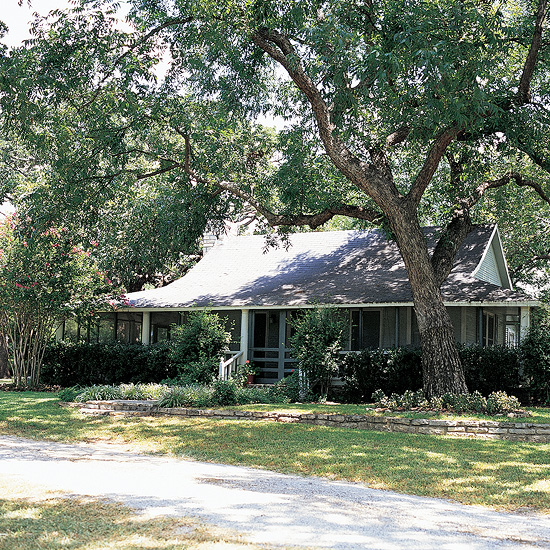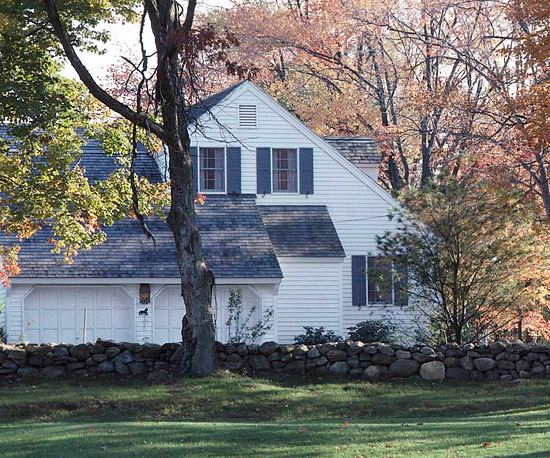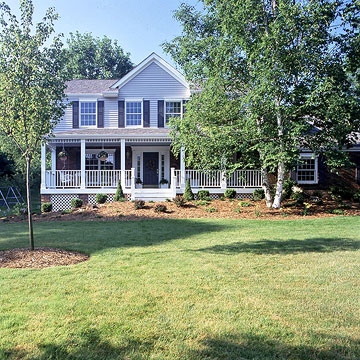Sitting under a shade tree on a hot day makes you cooler, and standing by a wall on a cold, windy day makes you feel warmer. It seems pretty obvious. What's less obvious is that you can landscape your yard to offer your home those same benefits. It just takes a bit of planning in the way you site trees, fences, and other elements.
Some statistics to illustrate the point:
continue reading below

Make your landscape a cool, shady retreat on hot summer days.
- A well-positioned tree can save up to 25 percent of your home's energy for heating and cooling.
- A tree-shaded yard can be up to 6 degrees cooler than a sunny yard. A shaded lawn can be up to 25 degrees cooler than sunny pavement.
- Shading your home's roof can increase your air conditioner's energy efficiency by more than 10 percent.
- A single shade tree equals the cooling power of 15 air conditioners -- and it runs for free!
- Three house-shading trees can cut your cooling bill by as much as half.
- Windbreaks can cut winter heating bills by 10 to 30 percent.
Find the best trees for your yard in Plant Encyclopedia!
After you've saved energy, find out how to save more money with our tips.
Regional Strategies for Energy-Efficient Landscaping
The Northeast: In most of your region, you want to take advantage of the sun's heat during the winter, so plant deciduous trees on the south- and west-facing sides of your home. This will do double duty: In summer, their leafy canopy will shade your house, helping to keep it cooler. It's also helpful to use a windbreak of trees or large shrubs to the north or northwest side of your home. This block will prevent winter winds from stealing as much of your home's heat.
Check out our guide to gardening in the Northeast.
The Midwest: The hot, blazing sun can make Midwestern summers uncomfortable. Help your air conditioner by planting large deciduous trees on the south or west side of your home. To reduce the heating costs during cold winter months, allow sun's rays to reach the south and west sides of your home. If possible, grow a windbreak of trees or shrubs on the north or northwest side of your house.
Check out our Midwest gardening guide.
The High Plains and Mountain West: Enjoy all those sunny winter days knowing your furnace is working less if the sun can shine on your home, providing radiant heat. We know that in many areas it's not feasible, but plant a windbreak if you can on the north side of your home. In summer, using deciduous trees on the sunny side of your house casts welcome shade.
Learn about top plants for your landscape in the Mountain West and High Plains.
The Pacific Northwest: Let the sun work for you: On those rare sunny winter days, its radiant heat can help your furnace if its warm rays can reach your house, so avoid planting evergreens on the south or southwest side of your home. Instead, select deciduous trees that lose their leaves in winter; they'll give the added benefit of shading your home from the hot sun in summer.
Discover landscaping ideas and strategies for the Pacific Northwest.
The South: Pay attention to the breeze and use fences or shrubs to help direct cooling breezes at your house. Likewise, help stop the sun from turning your home into an oven by planting large evergreen trees on the south or southwest side of your home. Decrease the effect of the humidity by planting drought-tolerant plants next to your home. Avoid siting thirsty plants next to your house; they're better suited for other corners of your yard.
Get landscaping tips for the South.
The Southwest: While summer heat can be intolerable, lessen its affect on your air conditioner by planting shade trees on the sunniest sides of your home. Because summer breezes are so rarely cool, use windbreaks to block the wind around your home.
Check out plants and planting strategies for landscapes in the Southwest.
Southern California: Unless you're lucky enough to live on the coast where it seems like the weather is always nice, you'll want to combat summer heat by planting big shade trees on the south and southwest side of your home. Also take a look at blocking those warm summer winds: Plant windbreaks around your home to deflect them.
Landscape to Reduce Winter Heating Costs
Minimize heating bills by doing the following:

Deciduous trees drop their leaves in winter, allowing the sun's warming rays to warm your home.
- Plant evergreens to block cold northwest winter winds. A windbreak protects an area up to 10 times as far out as its height -- so a series of 30-foot-tall trees can shield a 300-foot-wide area. Dense windbreaks can cut wind speed by 85 percent. Together these two effects can cut your winter heating bills by 25 percent.
- Place plantings, walls, or berms near -- but not against -- your home to create dead air space. This space acts as an insulator, slowing the escape of heat from your home.
- Plant deciduous trees, especially on the south side of a house. They can screen 70 to 90 percent of the hot summer sun yet allow breezes through. Deciduous trees also allow welcome winter sun to filter through the branches once they're bare. Deciduous vines serve the same purpose but, since they're smaller, do so to a lesser degree.
- Create open lawn areas on the south side of your home. These green, open areas create an area for snow to accumulate. The light reflected off the snow and onto your house can offer a radiant heating effect.
- Build a tall fence to slow winter winds. Not only will it lower heating bills, it will provide protection for less cold-hardy plants.
Test Garden Tip: Semi-open fences that allow some air movement through them are the most effective. Solid fences divert air over them with too much force and create an effect like a wind tunnel.
- Design stone or concrete surfaces around your home, such as a patio. It can soak up heat during the day and reflect it during a cool evening.
Landscape to Reduce Summer Cooling Costs
Maximize your air conditioner's efficiency by doing the following:

East-facing porches, patios, and decks stay cooler in the afternoon and evening hours.
- Build a pergola, ramada (a shade shelter open on three sides), awning, or other shade-giving structure on the west side of your house. It's an attractive way to filter light during the hottest part of the day. An open structure, such as a vine-covered pergola, is ideal as it allows cool breezes through and doesn't trap heat.
Check out our pergola ideas.
- Position porches, decks, and patios on the east side of your home. They'll become an ideal gathering spot because of their early morning warmth. And they won't be sauna-like during the late-day heat. A shade tree will keep the area even cooler.
- Think about your groundcovers. Light-colored stone or granite mulch and concrete will reflect more heat, making things hotter. Darker stone and wood chips will absorb the heat. A lawn or expanse of groundcover plants is the most cooling of all, but may require lots of water.
Discover easy-to-grow groundcover plants.
- Place trees where they'll shield your windows, especially those on the south and west sides, from direct sun. Deciduous trees are a great option as they block sun during hot weather but allow sunlight to filter through during cooler weather once their branches are bare.
- Funnel breezes through your property. Plant a row of trees on one side of the house and a wall on the other side of the house, to create a wind tunnel, for example. This will encourage stronger cooling breezes through the property and around the house.
- A water feature is cooling both physically and psychologically. A large pond upwind will noticeably cool the air of your whole landscape. A small pond or fountain can cool a smaller area.
See our collection of water garden ideas!
- Plant a cluster of trees to act as a low-tech air conditioner for the entire property, creating a cool zone which breezes can then distribute throughout the property and around the house.
Small-Scale Tips
- Take time to study the movement of sun and wind around your house and property through the seasons. You'll then be better able to control them with plantings and structures.
- Control sun through just a window or two by planting annual vines. Create a trellis of galvanized wire or build one of wood to surround or even cover the window. Plant with a deciduous vine, such as a sweet autumn clematis, morning glories, or scarlet runner bean. The vine's leaves will create filtered shade during the summer but allow light in during winter.
- Concentrate more on depth than height when planting a windbreak. One row of trees is good but two is better, and three is best. Start with a row of low-growing flowering trees and shrubs closest to the house, a row of taller deciduous trees in the next row, and a row of tall evergreens farthest out.
- Plant windbreaks on the north and northwest side of the house. Keep in mind, however, that in cold-winter areas you may well want the warming rays of the afternoon sun on the west side of your home. Plant a west windbreak far enough away to allow the low, slanting afternoon winter sun to reach the house.
- Berms are a great windbreak booster and can further help channel cold winter winds up and over a house.






 Make your landscape a cool, shady retreat on hot summer days.
Make your landscape a cool, shady retreat on hot summer days.
 Deciduous trees drop their leaves in winter, allowing the sun's warming rays to warm your home.
Deciduous trees drop their leaves in winter, allowing the sun's warming rays to warm your home.
 East-facing porches, patios, and decks stay cooler in the afternoon and evening hours.
East-facing porches, patios, and decks stay cooler in the afternoon and evening hours.